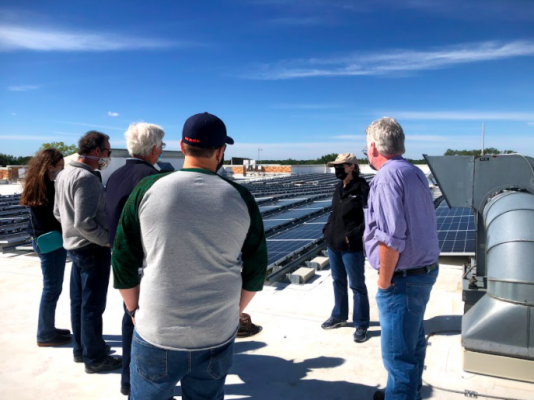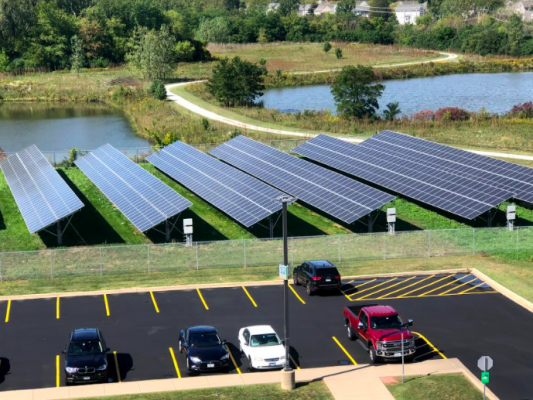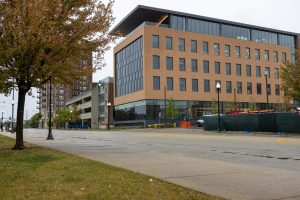College of Lake County transitions to solar energy
October 5, 2021
On September 25, the College of Lake County debuted its 5000 new solar panels during the Solar Tour event. Project Managers Scott Hardy and Dorothy McCarty and Sustainability Manager David Husemoller led the tour explaining all the functions and benefits of solar energy at CLC.

Sustainability Manager David Husemoller and Project Manager Dorothy McCarty
Husemoller shared information on the timeline of the project, with the planning beginning three years ago.
“Last fall, we started seeing [the ground panel] brackets go up really really fast, and then within a couple of weeks, they had it start to finish. It was incredible.” said Husemoller. “It took about three or four months for all the rest of the rooftops to get completed.”

Dorothy McCarty leads rooftop solar tour
As construction projects often go, there were roadblocks along the way that had to be overcome. “One of the biggest [complications] had to do with the age of the roofs,” said McCarty. “They were still in serviceable condition, and they weren’t scheduled to be replaced yet, but Verde, Onyx, and Fresh Coast will not install rooftop solar panels unless your roofs are still under warranty,” said Dorothy McCarty. To continue working with the three installation companies, CLC had to make a decision on redoing the roofs.
“So, the board did fund it, and the roofs had to be replaced, and we still had to make the deadlines. At any given time, they usually had three roofing crews here simultaneously to get the roofs done before they froze.”
Hardy worked hard to see that the work got done within the time crunch, and the solar panels went up on time.

Solar panels on roof of T building
The panels themselves are connected intricately to give power to multiple buildings. “Each rooftop, or system, goes into one building, and each building has its own meter,” said Husemoller.
In addition, the power collected from each rooftop set of panels is almost always used entirely, so none needs to be stored.
“Our buildings are so energy-intensive that there’s very little risk that we would overproduce and then send it out into the grid because we’re using everything we’re producing,” said Husemoller.
The use of solar energy is a big step in a sustainable direction for CLC and the state. However, it is not a complete transition; 16 percent of the electricity used at CLC will be solar, or as Husemoller illustrated, “the amount that we’re producing is the equivalent of 258 houses.”
The panels will also require little additional maintenance, making them an even more sustainable option for CLC’s power.
“The company that owns them will be inspecting them from time to time.” shared Husemoller. “They have remote monitoring as well, so that’s a good gauge on if a panel starts decreasing its productivity,” explained McCarty.

Ground set of panels adjacent to T building
This energy-efficient technology is also cost-efficient because CLC did not have to allocate any funds to purchase the panels. CLC acquired the solar panels through a Power Purchase Agreement.
“The state law enabled us to work with a third party, and there are financial benefits for them to install, own, and run the solar panels; what we do is we buy the electricity from them at a discount,” said Husemoller. Not only is the transition to solar energy beneficial to CLC, but to solar companies, the state, and the environment alike.
Solar energy is just one of the many steps in transitioning to more sustainable living. Husemoller stated that a new state law, called the Illinois Climate and Equitable Jobs Act, will help push Illinois into a more environmentally friendly state.
“The state just passed this law, setting the goal for us to be carbon-free as a state entirely by 2050,” said Husemoller. “That means we’re phasing out all of our coal, and cars are going electric, and everybody is going to get financial incentives to install solar anywhere we can. There are a number of layers of financial incentives to get us there.”






